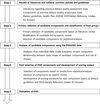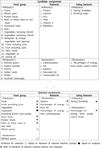Abstract
Purpose
The current study was conducted in order to develop the Korean Healthy Eating Index (KHEI) for assessing adherence to national dietary guidelines and comprehensive diet quality of healthy Korean adults using the 5th Korea National Health and Nutrition Examination Survey (KNHANES) data.
Methods
The candidate components of KHEI were selected based on literature reviews, dietary guidelines for Korean adults, 2010 Dietary Reference Intakes for Koreans (2010 KDRI), and objectives of HP 2020. The associations between candidate components and risk of obesity, abdominal obesity, and metabolic syndrome were assessed using the 5th KNHANES data. The expert review process was also performed.
Results
Diets that meet the food group recommendations per each energy level receive maximum scores for the 9 adequacy components of the index. Scores for amounts between zero and the standard are prorated linearly. For the three moderation components among the total of five, population probability densities were examined when setting the standards for minimum and maximum scores. Maximum scores for the total of 14 components are 100 points and each component has maximum scores of 5 (fruit intakes excluding juice, fruit intake including juice, vegetable intakes excluding Kimchi and pickles, vegetable intake including Kimchi or pickles, ratio of white meat to read meat, whole grains intake, refined grains intake, and percentages of energy intake from carbohydrate) or 10 points (protein foods intake, milk and dairy food intake, having breakfast, sodium intake, percentages of energy intake from empty calorie foods, and percentages of energy intake from fat). The KHEI is a measure of diet quality as specified by the key diet recommendations of the dietary guidelines and 2010 KDRIs.
References
1. Kang M, Joung H, Lim JH, Lee YS, Song YJ. Secular trend in dietary patterns in a Korean adult population, using the 1998, 2001, and 2005 Korean National Health and Nutrition Examination Survey. Korean J Nutr. 2001; 44(2):152–161.

2. Lim S, Lee EJ, Koo BK, Cho SI, Park KS, Jang HC, Kim SY, Lee HK. Increasing trends of metabolic syndrome in Korea -based on Korean National Health and Nutrition Examination Surveys-. J Korean Diabetes Assoc. 2005; 29(5):432–439.
3. Ahn BC, Hong EJ, Joung HJ. Regional convergence in the prevalence of metabolic syndrome in Korea. Korean Public Health Res. 2013; 39(1):1–11.
4. Patterson RE, Haines PS, Popkin BM. Diet quality index: capturing a multidimensional behavior. J Am Diet Assoc. 1994; 94(1):57–64.

5. Kennedy ET, Ohls J, Carlson S, Fleming K. The healthy eating index: design and applications. J Am Diet Assoc. 1995; 95(10):1103–1108.
6. Trichopoulou A, Kouris-Blazos A, Wahlqvist ML, Gnardellis C, Lagiou P, Polychronopoulos E, Vassilakou T, Lipworth L, Trichopoulos D. Diet and overall survival in elderly people. BMJ. 1995; 311(7018):1457–1460.

7. Huijbregts P, Feskens E, Räsänen L, Fidanza F, Nissinen A, Menotti A, Kromhout D. Dietary pattern and 20 year mortality in elderly men in Finland, Italy, and the Netherlands: longitudinal cohort study. BMJ. 1997; 315(7099):13–17.

8. Bailey RL, Miller PE, Mitchell DC, Hartman TJ, Lawrence FR, Sempos CT, Smiciklas-Wright H. Dietary screening tool identifies nutritional risk in older adults. Am J Clin Nutr. 2009; 90(1):177–183.

9. Haines PS, Siega-Riz AM, Popkin BM. The diet quality index revised: a measurement instrument for populations. J Am Diet Assoc. 1999; 99(6):697–704.
10. Kim S, Haines PS, Siega-Riz AM, Popkin BM. The diet quality index-international (DQI-I) provides an effective tool for cross-national comparison of diet quality as illustrated by China and the United States. J Nutr. 2003; 133(11):3476–3484.

11. Guenther PM, Reedy J, Krebs-Smith SM, Reeve BB, Basiotis PP. Development and evaluation of the healthy eating index-2005. Technical report. Alexandria (VA): U.S. Department of Agriculture, Center for Nutrition Policy and Promotion;2007.
12. Guenther PM, Reedy J, Krebs-Smith SM. Development of the healthy eating index-2005. J Am Diet Assoc. 2008; 108(11):1896–1901.

13. Guenther PM, Reedy J, Krebs-Smith SM, Reeve BB. Evaluation of the healthy eating index-2005. J Am Diet Assoc. 2008; 108(11):1854–1864.

14. Guenther PM, Casavale KO, Reedy J, Kirkpatrick SI, Hiza HA, Kuczynski KJ, Kahle LL, Krebs-Smith SM. Update of the healthy eating index: HEI-2010. J Acad Nutr Diet. 2013; 113(4):569–580.

15. McCullough ML, Feskanich D, Stampfer MJ, Giovannucci EL, Rimm EB, Hu FB, Spiegelman D, Hunter DJ, Colditz GA, Willett WC. Diet quality and major chronic disease risk in men and women: moving toward improved dietary guidance. Am J Clin Nutr. 2002; 76(6):1261–1271.

16. Woodruff SJ, Hanning RM. Development and implications of a revised Canadian healthy eating index (HEIC-2009). Public Health Nutr. 2010; 13(6):820–825.

17. Park YS, Han JL, Lee JW, Cho HS, Koo J, Kim JH, Yoon JS. The development of a simple evaluation questionnaire for screening the overweight-type dietary pattern in 30 to 49 year old adults. Korean J Community Nutr. 2002; 7(4):495–505.
18. Kim WY, Cho MS, Lee HS. Development and validation of mini dietary assessment index for Koreans. Korean J Nutr. 2003; 36(1):83–92.
19. Shim JE, Paik HY, Lee SY, Moon HK, Kim YO. Comparative analysis and evaluation of dietary intake of Koreans by age groups: (4) the Korean diet quality index. Korean J Nutr. 2002; 35(5):558–570.
20. Korea Health Industry Development Institute. Diet-related health risk appraisal (D-HRA) [Internet]. Cheongju: Korea Healthy Industry Development Institute;2013. Mar. 29. cited 2014 May 1. Available from: http://dhra.khidi.or.kr/index.do.
21. Lee JW, Kim KE, Kim KN, Hyun TS, Hyun WJ, Park YS. Evaluation of the validity of a simple screening test developed for identifying Korean elderly at risk of undernutrition. Korean J Nutr. 2000; 33(8):864–872.
22. Moon HK, Kong JE. Reliability of nutritional screening using DETERMINE checklist for elderly in Korean rural areas by season. Korean J Community Nutr. 2009; 14(3):340–353.
23. Lee HO, Lee JS, Shin JW, Lee GJ. Nutrition assessment of older subjects in a health care center by MNA (mini nutritional assessment). J Korean Diet Assoc. 2010; 16(2):122–132.
24. Ministry of Health and Welfare (KR). Dietary guidelines for Korean adults [Internet]. Seoul: Ministry of Health and Welfare;2009. Dec. 8. cited 2014 Mar 27. Available from: http://www.mw.go.kr/front_new/jb/sjb030301vw.jsp?PAR_MENU_ID=03&MENU_ID=0320&CONT_SEQ=224044&page=1.
25. Ministry of Health and Welfare (KR). Health plan 2020 [Internet]. Seoul: Ministry of Health and Welfare;2011. Jul. 22. cited 2014 Apr 17. Available from: http://www.mw.go.kr/front_new/jb/sjb030301vw.jsp?PAR_MENU_ID=03&MENU_ID=0319&CONT_SEQ=257824&page=1.
26. The Korean Nutrition Society. Dietary reference intake for Koreans. 1st revision. Seoul: The Korean Nutrition Society;2010.
27. Ministry of Health and Welfare, Korea Centers for Disease Control and Prevention. Korea National Health and Nutrition Examination Survey: primitive data download [Internet]. Cheongju: Korea Centers for Disease Control and Prevention;2013. Dec. 15. cited 2015 May 1. Available from: https://knhanes.cdc.go.kr/knhanes/index.do.




 PDF
PDF ePub
ePub Citation
Citation Print
Print







 XML Download
XML Download